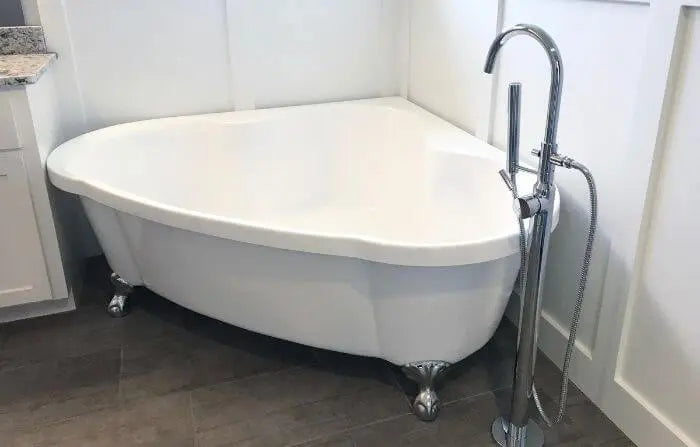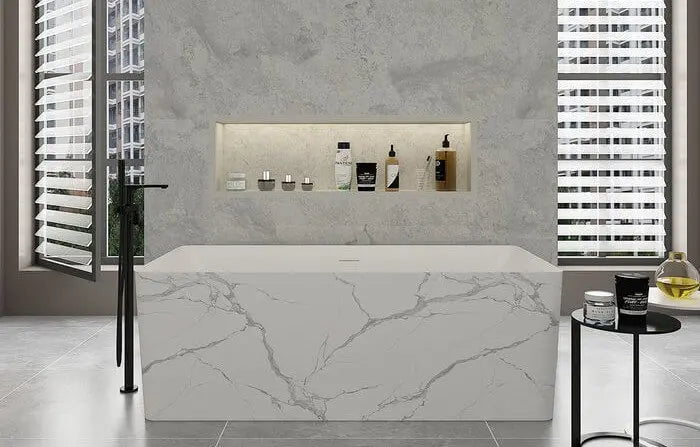
When it comes to designing a luxury bathroom, choosing the right type of bathtub is key to creating a space that’s as functional as it is beautiful. Drop in tubs and freestanding tubs are two of the top choices for homeowners and designers searching for a luxurious soaking tub for a spa-like bathroom.
When choosing between a drop-in tub and a freestanding tub for your bathroom remodel, it's important to understand the unique pros and cons of each. You'll also want to choose the tub style that best complements your bathroom’s layout and design.
Drop In Tub vs Freestanding Tub: An Overview
A drop-in tub is designed to fit into a precisely cut opening in a custom-built tub deck or platform. A drop-in tub is supported from below by a structural frame, with its ledge or rim resting on top of the surrounding deck or platform.
Drop-in tubs are known to be spacious and comfortable; they’re often equipped with whirlpool and/or air jets and are typically large enough to accommodate two people. Deck mount style tubs like drop-in tubs are especially ideal for luxurious spa-like bathrooms and wet rooms. According to the 2024 U.S. Houzz Bathroom Trends Study, deck mount style tubs like drop-in tubs are selected for 15 percent of wet room style bathroom remodels that feature bathtubs.
A freestanding tub, on the other hand, is a standalone tub that does not require a built-in surround or deck. It can be placed anywhere in a bathroom that has the necessary plumbing and floor support. Freestanding tubs are prized for their versatility, as homeowners can position them almost anywhere with adequate plumbing access—such the center of the room or under a window with a scenic view.
The wide range of shapes, styles, and materials to choose from also makes freestanding tubs highly popular with bathroom designers. Cast iron clawfoot tubs are a must-have for traditional and transitional bathroom designs, while sculptural stone resin or acrylic free standing tubs often serve as a focal point for modern and contemporary style bathrooms.
Drop In Tub vs Freestanding: Which Type of Tub is Easier to Install?
Most bathroom remodelers would agree that a freestanding tub is easier to install than a drop-in tub. That’s because a freestanding bathtub doesn’t require the construction of a surrounding deck or platform. Once the plumbing is in place, a freestanding tub can simply be set and connected, whereas a drop-in tub needs a custom-built frame and precise deck opening to accommodate and support the tub.
Drop In Tub vs Freestanding: Which Type of Tub is More Expensive?
Freestanding tubs range widely in price, starting at $800 with higher end models costing $7,000+. Most freestanding tubs cost between $1,500 and $4,000. Installation costs are typically minimal if plumbing is already in place. However, if new subfloor access or plumbing rough-ins are required, the additional labor and materials can cost anywhere from several hundred to several thousand dollars.
Drop-in tubs are typically less expensive, usually ranging from $600 to $1,500. High end drop-in tub models that cost $2,000 or more are also available. If you are looking for a drop-in tub with jets, it will typically cost $1,500 or more. However, the cost of building an enclosure for a drop-in tub is often several thousand dollars or more.
While freestanding tubs often have a higher upfront cost than drop-in tubs, the installation of a drop-in tub can ultimately be more expensive due to the additional construction costs required for the surrounding deck or enclosure.
Drop In Tub vs Freestanding: Which Tub Style Will Suit Your Bathroom?
Drop-in tubs and freestanding tubs differ greatly in style and aesthetics. The gentle curves of an oval drop-in tub will suit a traditional or transitional luxury style bathroom. Sleek, rectangular drop-in tub models fit well in alcoves and offer a modern, streamlined look that’s perfect for contemporary, spa-like bathrooms. A drop-in tub and enclosure can have a subtle, understated look or grand, luxurious aesthetic – it all depends on the tub shell that you choose as well as the style of the built-in enclosure used to support it.
Rectangular and oval flat-bottom freestanding tubs, on the other hand, provide a sleek, modern aesthetic that complements contemporary and modern luxury bathroom designs. Freestanding tubs are often incorporated into wet room bathroom designs which are trending in 2025. Because compact freestanding tubs can often fit into smaller spaces than drop-in tubs, since they don’t require a surrounding deck or enclosure, they are ideal for a small bathroom remodel.
While freestanding tubs grew in popularity in North America over the past ten years, built-in bathtubs such as alcove and drop-in style tubs, are currently making a comeback. However, the style of tub that you choose should ultimately be the one that best suits your overall design aesthetic, bathroom layout, and personal preference.
Drop In vs Freestanding Tub: Dimensions & Size
While drop in tubs and freestanding tubs are available in a variety of sizes, the overall dimensions of a drop-in tub are typically larger than a standalone tub due to the surrounding deck. While a drop-in tub and tub surround or enclosure may be bulkier than a freestanding tub, they can offer built-in storage, easier access for some users, and a more integrated look that blends with the overall design of a bathroom. A standard size drop-in tub is typically 60 inches long by 32 inches wide. The average water capacity of a standard size drop-in tub is 50-60 gallons. However, smaller and larger drop-in tubs are also available. In fact, a small drop-in tub installed in a tight alcove or corner may be more space-efficient than a standard size freestanding tub, which typically requires ample clearance (often between 6 and 18 inches) on all sides.
Many homeowners looking to create a spa-like bathroom oasis prefer the spaciousness of an extra large drop-in tub (72-78+ inches in length, 40-60 inches wide) designed to accommodate two people. Extra deep drop-in tubs that can hold 60+ gallons of water are also available.
Like drop-in tubs, freestanding tubs are available in a range of sizes, from extra small to extra large. While some freestanding tubs are large enough for two people, many homeowners opt for more modestly sized models that accommodate smaller bathrooms. A standard size freestanding tub is 55-72 inches (length) by 27-32 inches (width) by 15-20 inches (height).
Drop In Tub vs Freestanding: Optional Add-Ons
When it comes to selecting a luxury tub for your bathroom, you may want to consider what optional add-on features are available.
Common add-ons for drop-in tubs include whirlpool and air jet systems, which offer targeted massage through pressurized water or a gentle, effervescent air massage. Some drop-in tubs also have dual therapy (air and whirlpool jets) packages available. Many freestanding tubs are also available with air massage systems. If you're looking for a whirlpool jetted tub, a drop-in model is the best choice. The surrounding enclosure will conceal the plumbing and mechanical components of the water jet system.
Additional add-ons for drop-in tubs include chromotherapy lighting; built-in aromatherapy diffusers; inline water heaters to maintain temperature; digital touch controls; and built-in sound systems. These enhancements can transform a standard bathing experience into a personalized therapeutic spa retreat.
Some freestanding tub models can be painted black, bisque, or a custom color with marine coating paint. This optional feature (available with Barclay cast iron and acrylic freestanding tubs) can help designers create a custom centerpiece for any bathroom.
Freestanding Tub vs Drop In: Which Luxury Tub Is Best for Your Bathroom?
When it comes to choosing between a luxury drop-in tub and freestanding tub, you’ll want to consider installation difficulty and cost along with factors such as style, size, and add-ons like water or air jets and custom painting:
| Feature | Drop-In Tub | Freestanding Tub |
| Installation | More complex and labor-intensive; requires a built-in deck or tub surround | Easier to install if in-floor plumbing is already in place |
| Cost | Lower tub cost ($600–2,000+) but installation may be expensive | $800–7,000+ |
| Style/Aesthetics | Built-in look; can complement a range of bathroom styles including traditional, transitional & contemporary | Standalone statement piece; wide range of sculptural & modern styles available for modern & contemporary bathrooms |
| Dimensions & Size | Available in a variety of sizes; a large drop-in tub plus enclosure often takes up more room than a standalone tub | Available in many shapes and sizes; compact and extra-large tub models are available |
| Optional Add-Ons | Common add-on features include whirlpool jets, air jet systems, inline heaters, aromatherapy diffusers & chromotherapy lighting | Some freestanding tubs are available with air jet systems; custom color painting of tub exterior may be available |
All of the premium drop-in and freestanding tub models available in the Luxury Freestanding Tubs catalog include free shipping and warranty, along with 100% price match guarantee and money back guarantee.
For assistance with selecting the best luxury tub for your bathroom remodel, contact our Customer Service team!









